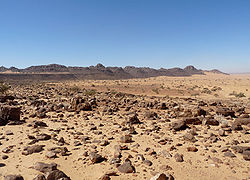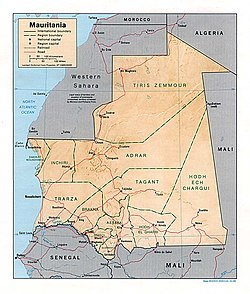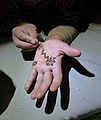Adrar Plateau
The Adrar
| |
|---|---|
Natural region | |
 Landscape of he stony desert known as Reg de l'Adrar | |
 Location of the Adrar in central Mauritania | |
| Country | Mauritania |
| Elevation | 340 m (1,120 ft) |
The Adrar (Berber: ![]() , lit. mountain) is a highland natural and historical region of the Sahara Desert in northern Mauritania. The Adrar Region, an administrative division of Mauritania, is named after the traditional region.
, lit. mountain) is a highland natural and historical region of the Sahara Desert in northern Mauritania. The Adrar Region, an administrative division of Mauritania, is named after the traditional region.
Geography
The Adrar is an arid plateau, known for its gorges, regs (stony deserts) and shifting sand dunes. Nearby is also the famous Richat Structure. Structurally the Adrar is a low central massif with conspicuous cliffs. There is no water in the central area of the plateau and cultivation is not possible; only at the edges there is enough water to support palm groves.
The Adrar region is home to a small human population, centered on the town of Atar. The ancient town of Ouadane, formerly an important caravan and gold-trading centre, is located on the southern edge of the Adrar. Chinguetti is another important historical town in the region.[1]
History
The Adrar was heavily settled in the Neolithic era. The more recent aridification has left much of the archaeology intact, most notable several stone circles[citation needed] and the later town of Azougui.
Beginning in mid-17th century, migrants from the Adrar Plateau region moved into the Tagant Plateau and displaced the native population.[2]
Features of the Adrar
-
Henna design on the hand of a girl of the region
-
A sandy area west of Chinguetti
-
A stone cairn
-
Colocynths in the Adrar desert
-
A postbox in the airport of Atar, the Adrar's main town





